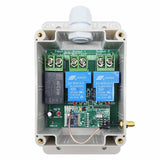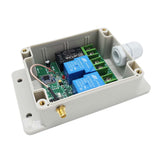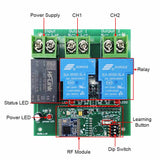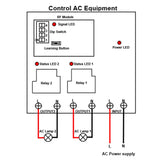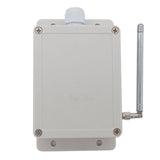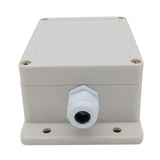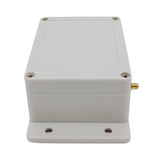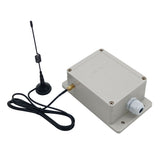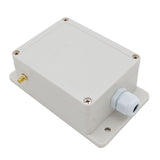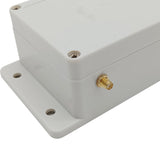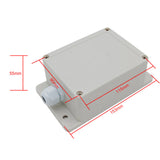Package Include:
1 x Receiver: S2PXW-AC-ANT3
1 x Transmitter: CC-2
1 x User manual
Introduction:
This receiver is a super long range remote switch. It is developed by LORA (Long Range) wireless communication technology, so it has ultra-long working distance, ultra-high receiving sensitivity, superior anti-interference ability, and smaller power consumption. It uses a transceiver chip to implement bidirectional communication. Its ideal working distance is up to 5 kilometers, which is an excellent device for remote control and long-distance communication.
Application:
This is a long distance 5000 meters 110V 220V high power 30A wireless remote control switch kit, with RF transmitter and 2 channels AC output radio receiver.
It can long range control AC equipments, such as lamp, LED lighting, motor, solenoid valve, pump, electric lock, etc.
Feature:
Wireless control, easy to install.
Super long working range: With the transmitter forming a complete set, the maximum working distance may reach 5000 meters in an open area.
Waterproof: The receiver has waterproof case and waterproof connector; it can be installed outdoors.
Universal input: Support 110V AC (110V~120V) used in US, Canada, etc, and 220V AC (220V~240V) used in Germany, UK, France, etc.
AC Power Output: It can control AC equipment with voltage AC 110V, 120V, 220V or 240V.
High Power: Each channel can work at maximum load current 30A.
With external antenna, the receiver has a farther working range.
The transmitter / remote can control the receiver from any place within a reliable working distance.
Wireless RF signal from the transmitter can pass through walls, floors, doors, or windows, but it will lose some operating range.
The receiver has reverse voltage protection and overcurrent protection.
The receiver can only be triggered by paired transmitters.
One or more transmitters / remotes can control one or several receivers simultaneously.
Two or more receivers may be used in the same area.
Feedback Function:
The receiver and the transmitter have a Two-way working mode, so the user can know the working status of the receiver by the transmitter.
Two-way working mode: When the receiver is successfully triggered by the signal from the transmitter, it will immediately transmit a feedback signal to the transmitter. When the transmitter receives this signal, it will send out a buzzing sound to inform you that the receiver has been successfully triggered.
Receiver Parameters:
Model No.: S2PXW-AC-ANT3
Operating Voltage: 110~240V AC (110V/120V/220V/240V)
Output Type: 110~240V AC (110V/120V/220V/240V)
Quiescent Current: ≤6mA
Maximum Load Current of Relay: 30A
Channel: 2 Way
3 Selectable Modes: Self-locking, Momentary, Interlocking
Working Frequency: 433.92 MHz
Wire Range of Terminals: 22-12AWG
Operating Temperature: -20°C ~ +70°C
PCB size: 88 x 80 x 18 mm
Case size: 153 x 90 x 55 mm
Transmitter Parameters:
Model: 0021061 (CC-2)
Channel / Button: 2
Button Symbol: A, B
Operating Voltage: 9V (1 x 6F22-9V battery)
Quiescent Current: 5μA
Working Current: 65mA (when the transmitter is transmitting the signal), 16mA( when the transmitter is receiving the signal).
Operating Frequency: 433.92 MHz
Modulation Mode: FSK + LORA
Feedback indication: buzzing sound
Transmitting Distance: 5000 meters / 15000 feet (theoretically)
With power switch on the side.
Unit Size: 135 x 42 x 25 mm (5.3 x 1.7 x 1.0 inches)
Matching Transmitters:
The receiver only works with 5000 meters transmitters, such as model CC-2 (5000 meters / 15000 ft range) and CCW-2 (waterproof, 5000 meters / 15000 ft range).
Working Range:
With the transmitter (such as CC-2) forming a complete set, the maximum working distance may reach 5000 meters in an open area.
The maximum working distance is based on theoretical data which would be without barriers and without any RF interference. In practice, it will be hindered by trees, walls or other construction, and will be interfered with by other wireless signals. Therefore, the actual working distance may not reach this maximum distance.
Usage:
The receiver can be used to control AC 110~240V (110V/120V/220V/240V) equipments.
Wiring:
1) Connect the live wire of the AC device to the output terminal "L/+" of the receiver;
2) Connect the neutral wire of the AC device to the output terminal "N/-" of the receiver;
3) Connect the live wire of the AC power supply to the input terminal "L/+" of the receiver;
4) Connect the neutral wire of the AC power supply to the input terminal "N/-" of the receiver.
Setting different control modes:
1) Setting Self-locking mode: Turn on the third bit of the dip switch.
The operation of Self-locking mode with the transmitter CC-2:
Press the button A on the transmitter: The output terminal "Output1" of the receiver outputs AC power, and the connected lamp 1 is turned on.
Press the button A again: The output terminal "Output1" of the receiver stops outputting, and the connected lamp 1 is turned off
Press the button B on the transmitter: The output terminal "Output2" of the receiver outputs AC power, and the connected lamp 2 is turned on.
Press the button B again: The output terminal "Output2" of the receiver stops outputting, and the connected lamp 2 is turned off.
2) Setting Momentary mode: Turn off the second bit and the third bit of the dip switch.
The operation of Momentary mode with the transmitter CC-2:
Press and hold the button A on the transmitter: The output terminal "Output1" of the receiver outputs AC power, and the connected lamp 1 is turned on.
Release the button A: The output terminal "Output1" of the receiver stops outputting, and the connected lamp 1 is turned off.
Press and hold the button B on the transmitter: The output terminal "Output2" of the receiver outputs AC power, and the connected lamp 2 is turned on.
Release the button B: The output terminal "Output2" of the receiver stops outputting, and the connected lamp 2 is turned off.
3) Setting Interlocking mode: Turn on the second bit of the dip switch.
The operation of Interlocking mode with the transmitter CC-2:
Press the button A on the transmitter: The output terminal "Output1" of the receiver outputs AC power, and the connected lamp 1 is turned on; The output terminal "Output2" of the receiver stops outputting, and the connected lamp 2 is turned off.
Press the button B on the transmitter: The output terminal "Output2" of the receiver outputs AC power, and the connected lamp 2 is turned on; The output terminal "Output1" of the receiver stops outputting, and the connected lamp 1 is turned off.
How to set the feedback function:
You can turn on the fourth bit of the dip switch to activate the feedback function; or turn off the fourth bit to deactivate the feedback function.
Attention: The first bit of the DIP switch on the receiver needs to be set to the ON position.
How to pair the transmitter to the receiver:
1) Press the learning button in the receiver for 1-2 seconds, until the signal LED on the receiver turns on, this indicates that the receiver enters the learning status.
2) Press any one button on the transmitter within 5 seconds, if signal LED flashes 3 times quickly and then goes off, this indicates that the pairing is successful.
3) The receiver can learn several transmitters with different codes.
How to delete all transmitters codes stored in the receiver:
Press and hold the learning button in the receiver for 3-4 seconds, the signal LED first comes on, then flashes 3 times quickly and then goes out, at this time release the learning button, this indicates that all stored codes have been successfully deleted successfully.
















